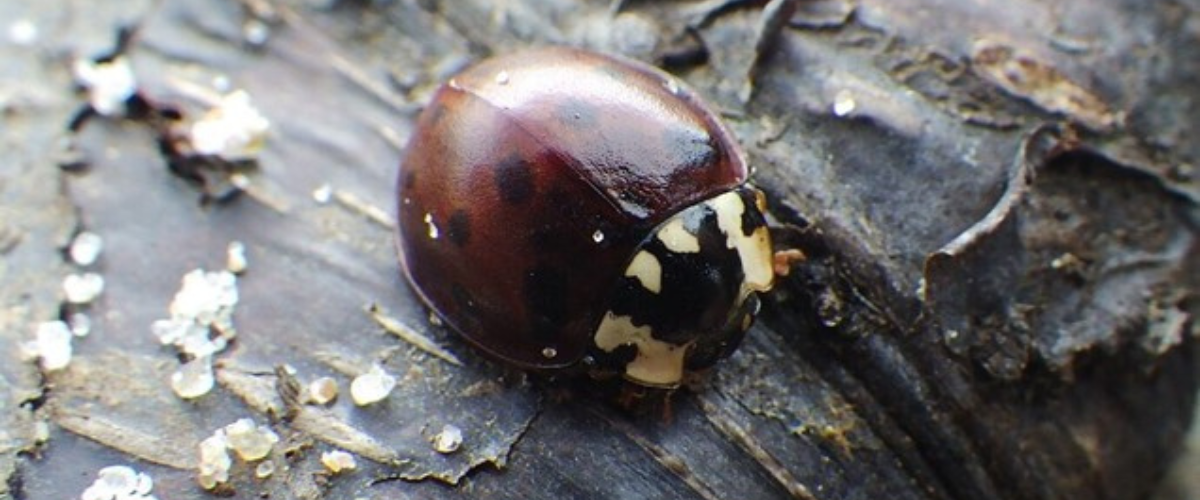First discovery of the Fifteen-spotted Lady Beetle in Alberta
by Matthias Buck, Assistant Curator of Invertebrate Zoology
Have you ever planned a weekend camping trip to one of your favorite destinations and then bad weather put a damper on your plans? This recently happened to me when I visited Cold Lake in eastern Alberta. I was taking part in the annual field trip of the Alberta Lepidopterists' Guild (ALG), a wonderful group of butterfly and moth enthusiasts. Cold Lake was chosen as the destination because it is one of the few places in Alberta where the spectacular Luna Moth, Actias luna (https://bugguide.net/node/view/562) is found. This charismatic species is widely distributed and fairly common in eastern Canada. Luna moths are also known from Manitoba and Saskatchewan, but they are so rare in Alberta that nobody was certain they occurred here until the year 2012.
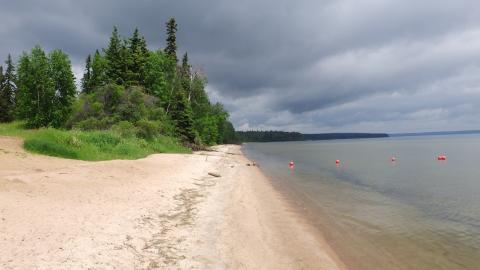
In fact, I was full of anticipation for this trip because I had never seen one of these beauties of the night alive. A couple of weeks before it took place, I started to get worried, though, because nearby wildfires blanketed the area with smoke. Luckily, just in time for the trip, a cold front blew through. It cleared the air, but cold temperatures and rainy weather quenched insect activity. We only saw a few moths that weekend and none of them were Luna Moths. How disappointing!
One of the wonderful things about nature is that there is always something to discover, regardless of the circumstances. And indeed, as I was walking down the beach, I noticed an interesting natural phenomenon I had never witnessed with my own eyes: a wash-up of lady beetles. You might have never heard of such a thing before, but this is what lady beetle researchers dream of! Hundreds or even thousands of lady beetles get washed up on a lakeshore, usually after a storm. How does it happen? Like most beetles, lady beetles are able to fly, but they are not very strong fliers. They often fall into the water, but unlike many other insects they float very well because of the air that is trapped under their wing covers. During a storm, a larger number than usual falls into the water, and if the right wind conditions are right, they get washed up on shorelines en masse. There is no better way to quickly find out what species of lady beetles occur in an area than studying wash-ups like this (Image 1)!
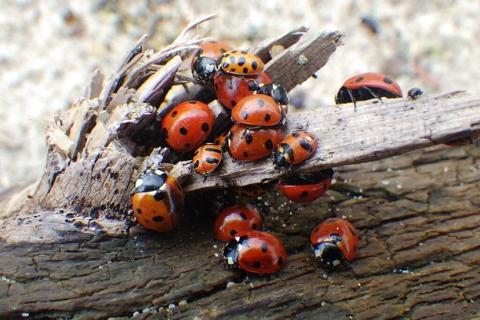
So, I went down on my knees with one of my entomologist friends from the Guild, and we spent several hours collecting and photographing lady beetles on two different beaches. Our effort was rewarded far beyond our expectations! We found 23 different species of lady beetles, which are listed at the end of the article. This amounts to roughly two-thirds of the species known from northeastern Alberta (37 species), and more than a quarter than the total number of species known from the province (81 species)!
The most remarkable discovery was the Fifteen-spotted Lady Beetle (Anatis labiculata) (see images). With 7-9.5 mm body length it is one of the largest lady beetle species in Canada. Even though known from nearby Saskatchewan, this species had never been found before in Alberta! Here the story serendipitously comes full circle with the elusive Luna Moth. Just like the moth, this beetle is primarily distributed in eastern North America (see map below), but its range narrowly extends into northeastern Alberta in the Cold Lake area. We did not find the Luna Moth that weekend, but we made an even more remarkable discovery!
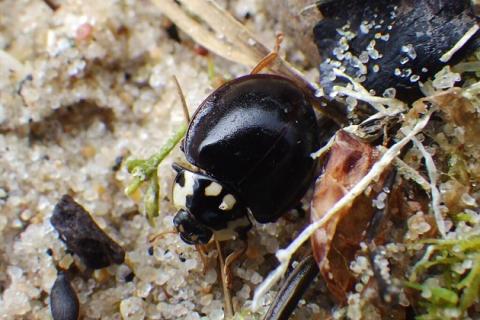
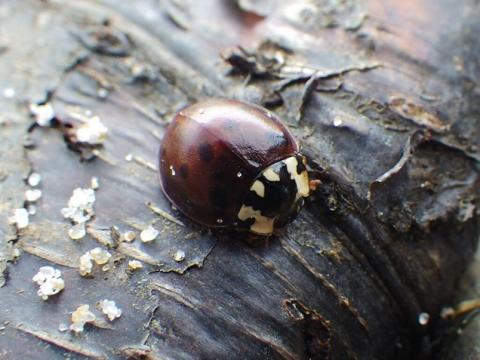
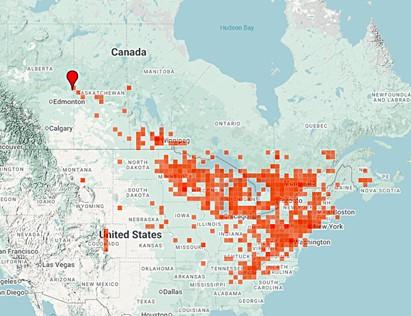
Looking at the images above you might be wondering why the species is called Fifteen-spotted Lady Beetle. Like many lady beetle species, it is variable and has three different colour forms. A pale form where the fifteen spots on the wing covers jump out immediately, a dark red form that barely reveals the spots and a black form that isn't spotted at all. I only found one each of the black and dark red forms (see Images 2 & 3). The latter can be confused with the closely related Eye-spotted Lady Beetle (Anatis mali), a species that occurs throughout Alberta. This species also has fifteen spots, but each spot has a conspicuous yellow ring around it (see Image 5).
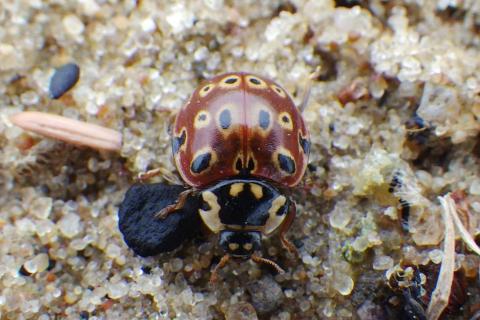
We also found two other species that I wrote about in a blog post in October 2022 (https://royalalbertamuseum.ca/blog/meet-your-new-neighbour): the Variegated Lady Beetle (Hippodamia variegata), and the Transverse Lady Beetle (Coccinella transversoguttata). Back then, the former had just arrived in Alberta and was only known from the Capital Region. Just three years later the species also showed up in Calgary and in a couple more out-of-the-way locations in Brazeau County and Kneehill County (source iNaturalist: https://www.inaturalist.org/observations?place_id=6834&subview=map&taxon_id=143034). We found just one beetle on that beach at Cold Lake (see Image 6), but it currently represents the northernmost find of this species in the western hemisphere! It will probably be found in many more areas of Alberta in the near future.
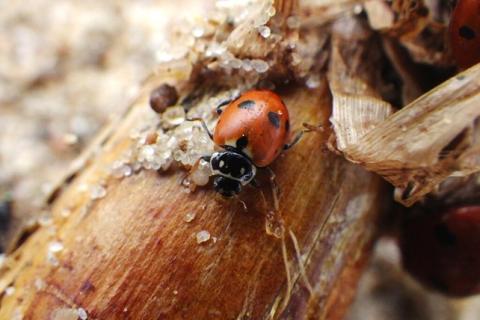
Its native relative, the once common Transverse Lady Beetle, seems to be recovering slightly from the brink of extirpation. When I wrote my post in 2022, I had never seen one of these beetles, in 2023 I found one, in 2024 two (all in southern Alberta), and now we discovered at least eight at Cold Lake. This, of course, is not a statistically significant trend but it does looks like there is an increase in observations of this rare species in recent years (Image 7).
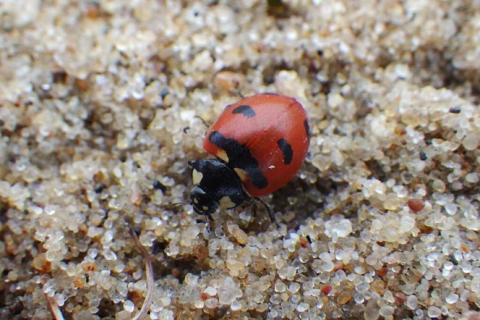
As this weekend trip demonstrated: we still have much to learn about the distribution of Alberta lady beetles. You can contribute to this effort and make a difference by photographing them and uploading your pictures to citizen science platforms such as iNaturalist.ca. New discoveries can literally happen in your backyard - you never know!
Solution to the quiz: image #2 shows four different species of lady beetles (10 Seven-spotted Lady Beetles, 3 Thirteen-spotted Lady Beetles, 1 Three-banded Lady Beetle and 1 Five-spotted Lady Beetle, the tiny black beetle on the right is not a lady beetle).
Lady Beetle species observed at Cold Lake, Alberta, from June 14-15, 2025 (in alphabetical order according to scientific names, in parentheses). Each species includes a hyperlink to an observation from Cold Lake (most by the author, except where noted otherwise):
- Two-spotted Lady Beetle (Adalia bipunctata): https://www.inaturalist.org/observations/291587780
- Fifteen-spotted Lady Beetle (Anatis labiculata), see above
- Eye-spotted Lady Beetle (Anatis mali), see above
- Marsh Lady Beetle (Anisosticta bitriangularis): https://www.inaturalist.org/observations/290530663
- Cream-spotted Lady Beetle (Calvia quatuordecimguttata): https://www.inaturalist.org/observations/291382196
- Twice-stabbed Lady Beetle (Chilocorus stigma): https://www.inaturalist.org/observations/25762145 (observed by Emily Gorda)
- Hieroglyphic Lady Beetle (Coccinella hieroglyphica): https://www.inaturalist.org/observations/290527314
- Seven-spotted Lady Beetle (Coccinella septempunctata): https://www.inaturalist.org/observations/290325582
- Transverse Lady Beetle (Coccinella transversoguttata): https://www.inaturalist.org/observations/291382205
- Three-banded Lady Beetle (Coccinella trifasciata): https://www.inaturalist.org/observations/290574265
- American Lady Beetle (Hippodamia americana): https://www.inaturalist.org/observations/102374693 (observed by Jason Headley in BC, no images from Alberta available)
- Convergent Lady Beetle (Hippodamia convergens): https://www.inaturalist.org/observations/290320696
- Glacial Lady Beetle (Hippodamia glacialis): https://www.inaturalist.org/observations/291389673
- Parenthesis Lady Beetle (Hippodamia parenthesis): https://www.inaturalist.org/observations/290569536
- Five-spotted Lady Beetle (Hippodamia quinquesignata): https://www.inaturalist.org/observations/290589829
- Sinuate Lady Beetle (Hippodamia sinuata): https://www.inaturalist.org/observations/290318997
- Thirteen-spotted Lady Beetle (Hippodamia tredecimpunctata): https://www.inaturalist.org/observations/290565139
- Variegated Lady Beetle (Hippodamia variegata): https://www.inaturalist.org/observations/291386300
- Vittate Lady Beetle (Hyperaspidius cf. vittigerus): https://www.inaturalist.org/observations/290535435
- Episcopal Lady Beetle (Macronaemia episcopalis): https://www.inaturalist.org/observations/290327069
- Hudsonian Lady Beetle (Mulsantina hudsonica): https://www.inaturalist.org/observations/291378841
- Streaked Lady Beetle (Myzia pullata): https://www.inaturalist.org/observations/291378842
- Twenty-spotted Lady Beetle (Psyllobora vigintimaculata): https://www.inaturalist.org/observations/290535431
